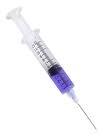Eighty per cent of the teenage girls offered a controversial cervical cancer vaccine in schools last term availed of the  jab, according to new figures revealed yesterday.
jab, according to new figures revealed yesterday.
The Health Service Executive (HSE) confirmed that 1,300 first-year girls received the first dose of the vaccine in May, as part of the limited rollout before it is extended in the autumn.
The vaccine, Gardasil, which the HSE began to use in May, is targeted at school-girls in the 12-13 age group against HPV 16 and 18 viruses which give rise to 70 per cent of all cervical cancers. HPV, or Human Papillomavirus Virus, is sexually transmitted.
Parents were sent out information packs and consent forms in advance of the vaccination beginning.
However, some parents have expressed reservations about vaccinating their daughters against a sexually transmitted disease at such a young age.
Furthermore, the information campaign accompanying the vaccination programme has been criticised for not properly informing parents about HPV.
In particular, the HSE information pack about the vaccine does not inform parents and/or their children that the chances of contracting a HPV rise according to the number of life-time sexual partners a person has.
The National Immunisation Advisory Council (NIAC) has published a booklet on various viruses. In its chapter on HPV, it says that individuals “can reduce their risk of getting genital HPV infection by changes in sexual behaviour including abstinence from any sexual activity or lifelong monogamy”.
It continues: “Reducing the number of sexual partners and the frequency of new partners will also reduce the risk. Condom use reduces but does not eliminate the risk of sexual transmission of HPV.
This finding is confirmed by Dutch research showing that women who had more than 10 lifetime sexual partners had a 50 per cent chance of contracting a HPV. This compared to women who had a single lifetime sexual partner, who had a 4.2 chance of having contracting the virus.
Others have criticised similar vaccination programmes. In an article in 2008 in the New England Journal of Medicine (NEJM), Drs Jane Kim and Sue Goldie suggest that the vaccination of girls aged 12 and over might only reduce the risk of cervical cancer by two per cent compared to screening alone.
They suggest that this might not be very cost-effective compared with other ways in which the cost of such programmes might be spent.
The HSE says that the vaccine is likely to be effective for 10-15 years but has admitted that, based on current research, it can’t guarantee that it will be effective for more than five years.
Drs Kim and Goldie also suggested that there is a possibility that the HPV types targeted by the vaccine could be replaced with other high-risk types for which the vaccine offers no protection;
They also expressed the fear that the vaccination programme may have the effect of altering the sexual behaviour of young people (they will take more risks) or lead to the misconception that screening is no longer necessary.
The girls who received the vaccine last term will have to go to a health clinic this month for the second of three doses, which are part of the vaccination programme. A spokesman for the HSE said appointments had been given for the second dose and the vaccinations would take place in clinics before the end of this month.
A spokesman for the Irish Medicines Board (IMB) said it had received 11 reports of suspected adverse reactions associated with cervical cancer vaccines. One of these was linked to Cervarix, and 10 with Gardasil.
The majority of those reports received to date relate to expected adverse reactions for the product, and include cases of hypersensitivity, enlargement of the lymph nodes, fainting and an allergy-related skin rash.
The studies so far show that protection lasts for at least five years after a full course.
There are 250 new cases of cervical cancer diagnosed every year, and 80 die of the disease.
The full impact of the vaccine will take many years to be seen.
A recent study showed that the prevalence of HPV among Irish urban women was 19.8 per cent, varying from 31 per cent in women under 25, to 23 per cent in women aged 25-35 and 11 per cent in women over 35 years of age. HPV 16 at 20 per cent and HPV 18 at 12 per cent were the commonest high-risk types detected.
In the vast majority of cases HPV does not lead to cancer, and it usually clears up without treatment.















